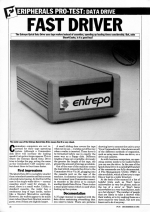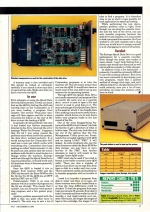
Personal Computer News
 15th December 1984
15th December 1984
Author: Stuart Cooke
Published in Personal Computer News #091
The Entrepo Quick Data Drive uses tape wafers instead of cassettes, speeding up loading times considerably. But, asks Stuart Cooke, is it a good buy?
Fast Driver
The Entrepro Quick Data Drive uses tape wafers instead of cassettes, speeding up loading times considerably. But, asks Stuart Cooke, is it a good buy?
Commodore computers are not renowned for their tape operating system. Although a Commodore disk drive will increase the loading speed it's at quite a large expense. This is where the Entrepro Quick Data Drive tries to bridge the gap, acting the same as the Commodore C2N cassette unit, but about three to four times faster.
First Impressions
The Quick Data Drive is slightly smaller than a standard cassette and has a cream coloured metal casing. At the front of the case is the single wafer drive - normal cassettes aren't used for storage, instead, there is a small wafer. Unlike a standard casssette, the wafer has a continuous loop of tape inside, rather like a Sinclair Microdrive cartridge. However, the wafers appear to be much more robust than their Sinclair counterparts, even if they are slightly larger.
A small sliding door covers the tape when not in use - it slides out of the way when a wafer is inserted. These have to be formatted before use in exactly the same way as a floppy disk. Different lengths of tape are available: obbiously, the greater the length of the tape, the greater the amount of storage available.
Out of the rear of the machine comes the lead which connects the drive to the Commodore 64 or Vic 20, plugging into the cassette port on the rear of the machine. A connector is provided on the rear to connect your Commodore cassette recorder to the drive or to connect another Quick Data Drive. There is also a small push button which is used when booting up the system.
Documentation
A 37 page manual is supplied with the data drive containing everything that you need to know. There are pictures showing how to connect the unit to your Vic or Commodore 64. Also shown are all of the different methods of expansion, such as using more than one drive, or a drive and cassette.
As with business computers, an operating system needs to be loaded before you can use the drive. In the case of the Quick Data Drive it is called QOS and all of the commands are fully documented. A File Management Utility (FMU) is also available, which allows you to copy files or load in a wafer directory.
At the back of the manual is a list of helpful hints such as "Don't leave microwafers in very hot places, such as microwafers in a very humid place, such as a hot shower." The number of people that are likely to take a shower with their wafers, or to try cooking them on a stove must be very small, but now you know not to do it anyway.
A memory map is also included and this should be looked at extremely carefully if you intend to store any data or use machine code. Make sure that you don't overwrite the QOS.
In Use
First attempts at using the Quick Data Drive failed miserably. Firstly tou must boot up the QOS by hitting the shift and run/stop keys on the Commodore as if you were loading a program from cassette. The normal "Press play" message will then appear and this is when you press the button on the rear of the drive to start the loading of QOS.
It seemed to do this perfectly, but once it had loaded any further commands directed to the drive returned the error message "Wafer Not Present". It appears that the C64 I was using caused the problems since when tried with another, the data drive worked perfectly. It is worth noting that the Commodore 64 I used was a new one which works with everything else. Commodore does keep making so-called 'improvements' to the C64 and I can only assume that the initial problems with the drive must be due to a change within the machine. Entrepo said that although the Quick Data Drive was pre-production, it should work with all machines when it becomes generally available.
Once the QOS is loadeed it sits in memory from location C000 and the FMU sits beneath the Basic ROM on the C64. On the Vic 20, the QOS sits at 6FFF and the FMU sits at 57FF.
Unfortunately, C000 is an area of memory which a number of programs on the C64 use already. This meant that I couldn't run my favourite word processing program and a few games programs.
Another problem associated with the QOS is that you quite often have to reload it. The only way to exit a lot of Commodore programs is to turn the machine off. This obviously means that you lose the QOS. It would have been so much nicer if the unit didn't use up any memory for its Operating System.
Through QOS the Quick Data Drive can handle sequential and program files in exactly the same way as a cassette drive. OPEN# is used to open a file and PRINT# is used to send data to it. The main advantage of the Quick Data Drive is the speed at which it can handle data files, making it much more useful than a cassette, which forces you to wait hours before your program reads in the last record of the file.
One of the most disappointing features of the QOS is that it doesn't include the facility to get a directory of what is held on tape. The only way to do this is to use one of the options that the File Management Utility gibves you. Fortunately, this is loaded together with QOS and on typing LOAD "FMU" it will appear. As some programs also use the area of memory under the Basic ROM for data storage, you may have to wave bye-bye to the FMU. Any further attempts to load it will result in the message "Insert QOS wafer".
FMU must also be used if you wish to format a new wafer or create a new QOS wafer. There are also a number of options that allow you to copy files from tape or disk to a wafer and vice versa. This is extremely useful and enabled me to transfer programs with no trouble at all.
I used it to transfer a program from disk to wafer and then on to tape. All three versions were then loaded back in so that the time differences could be checked. To load the program from tape took one minute 30 seconds; from disk it took 15 seconds and from wafer it took 20 seconds, a vast improvement over cassette. Obviously the longer the length of tape in the cartridge, the longer it will take to find a program. It is therefore wise to use as short a tape possible for each application to speed up loading.
While performing the test above, another problem came to light. Even though you can plug the cassette recorder into the rear of the drive, you can only transfer programs between the data drive and cassette; it is not possible to load a program from cassette. So if you wished to use both cassette and a data drive you would have to resign yourself to a lot of plugging in and out of sockets.
Verdict
The Entrepod Quick Data Drive is a good replacement for a cassette recorder. Even though the metal vase makes it more robust, I can't help feeling that a plastic case would have done just as well and would have made it a little cheaper.
In addition it has a few bad points - primarily it would be extremely difficult to use with existing software. But if you are more interested in developing your own programs, would like a quicker method of storage than tape, and can't afford a disk drive, the Quick Data Drive could certainly save you a lot of time, providing you keep the memory problems in mind.
Report Card
Features 3/5
Documentation 4/5
Performance 3/5
Overall Value 3/6
This article was converted to a web page from the following pages of Personal Computer News #091.



